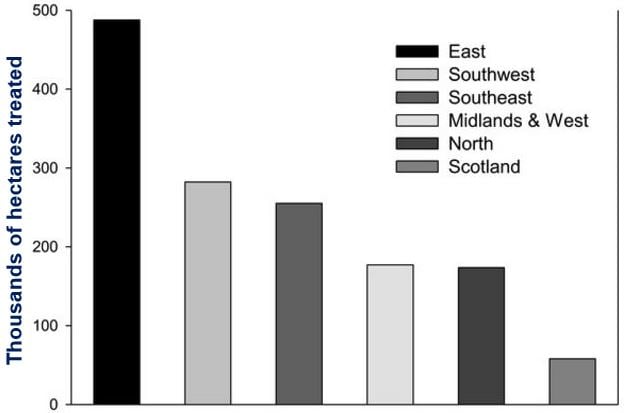The British butterfly population has been declining dramatically, and scientists now believe it is partly due to neonicotinoid pesticide usage after carrying out a study. Neonicotinoids are a class of neuro-active insecticides that are chemically similar to nicotine.
Previous studies have shown that these chemicals appear to be harming several species of wildlife, including birds and bees.
Scientists from the Universities of Sussex and Stirling, together with the Centre for Ecology and Hydrology and Butterfly Conservation wrote in the academic journal Peer J that theirs is the first study with scientific evidence of a possible negative effect on British butterflies.
 The Small Tortoiseshell (Aglais urticae L.) was among 15 species of butterflies showing declines linked to neonicotinoid pesticide use. (Image: Wikipedia)
The Small Tortoiseshell (Aglais urticae L.) was among 15 species of butterflies showing declines linked to neonicotinoid pesticide use. (Image: Wikipedia)
Neonicotinoid pesticides build up in wild flowers
Neonicotinoid pesticides remain in the environment and can be absorbed by the wild flowers that grow in field margins. Field margins are an important source of nectar for butterflies and food-plant for their juveniles (caterpillars).
According to Butterfly Conservation, neonicotinoid pesticides were first introduced in the mid-1990s to replace older chemicals. They are systematic insecticides, i.e. they are absorbed into every single cell in a plant, making all parts poisonous to insects.
Dave Goulson, Professor of Biology at the University of Sussex, and colleagues found that population trends of 15 different butterfly species showed declines linked to neonicotinoid pesticide use, including Wall, Small Skipper and Small Tortoiseshell species.
The study is based on information gathered by volunteer workers from over 1,000 sites across Britain as part of the long-running UK Butterfly Monitoring Scheme (UKBMS).
Prof. Goulson said:
“Many of us can remember a time when our meadows and hedgerows had far more butterflies, bees and other insects than today. This study adds to the growing mountain of evidence that neonicotinoids are one of the causes of these declines.”
 The area in thousands of hectares treated with neonicotinoid pesticides in 2010 in different regions of England and Scotland. Data from Defra (2014). (Image: peerj.com)
The area in thousands of hectares treated with neonicotinoid pesticides in 2010 in different regions of England and Scotland. Data from Defra (2014). (Image: peerj.com)
Neonicotinoid’s impact on many species may be huge
Study leader Dr. Andre Gilburn, an ecologist who works at the University of Stirling, said:
“Our study not only identifies a worrying link between the use of neonicotinoids and declines in butterflies, but also suggests that the strength of their impact on many species could be huge.”
Head of Monitoring at Butterfly Conservation, Dr. Tom Brereton, said:
“We are extremely concerned with the findings of the study and are calling for urgent research to see whether the correlations we found are caused by neonicotinoid use, or some other aspect of intensive farming.”
“Widespread butterflies have declined by 58 percent on farmland in England over the last 10 years, giving concern for the general health of the countryside and for these and other insects in particular.”
In the journal, the authors concluded:
“If neonicotinoids are driving the decline in widespread butterflies in the UK, this begs the questions as to what other non-target arthropods might be similarly affected and whether neocotinoids are playing a role in the declines in insectivorous farmland birds in the UK.”
Citation: “Are neonicotinoid insecticides driving declines of widespread butterflies?“ Andre S. Gilburn, Nils Bunnefeld, John McVean Wilson, Marc S. Botham, Tom M. Brereton, Richard Fox and Dave Goulson. 24 November, 2015. PeerJ 3:e1402. https://dx.doi.org/10.7717/peerj.1402.
